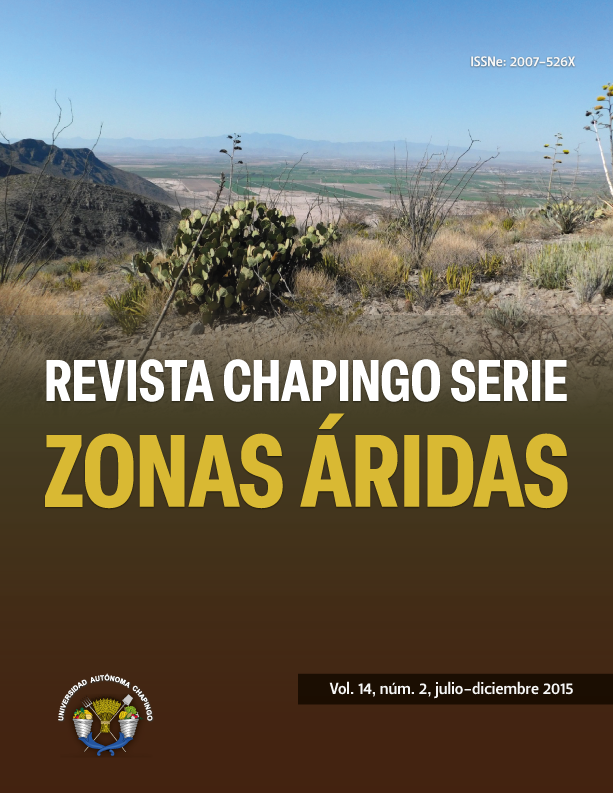Resumen
En los últimos años se ha incrementado tanto la frecuencia como la gravedad de los episodios de sequía, y se prevé que las zonas afectadas por ella aumenten en extensión. Entre los efectos de la sequía, se destaca la amenaza constante para la producción de alimentos, aumento de plagas y enfermedades, incendios forestales, degradación de tierras y la erosión del suelo, entre otros. De ahí que se deriva la importancia de su análisis y cuantificación para proceder con acciones de mitigación de dichos efectos. En tal contexto, el objetivo del presente trabajo es mostrar una descripción del monitoreo básico de variables climatológicas y su aplicación para caracterizar las sequías y la determinación de áreas vulnerables a la ocurrencia de dicho fenómeno, mediante la presentación de un estudio de caso para la región sureste del estado de Coahuila. Para ello, se emplearon datos climáticos provenientes de la red de estaciones agroclimáticas automáticas del Instituto Nacional de Investigaciones Forestales, Agrícolas y Pecuarias (INIFAP), los cuales fueron analizados mediante índices climatológicos.
Citas
Alley, W. M. (1984). The Palmer Drought Severity Index: Limitations and Assumptions. Journal of Climate and Applied Meteorology, 23 (7), 1100 -1109. doi: https://doi.org/10.1175/1520-0450(1984)023<1100:TPDSIL>2.0.CO;2
Allen, R. G., Pereira L., Raes, D., & Smith, M. (1998). Crop evapotranspiration- Guidelines for computing crop water requirements. FAO Irrigation and Drainage Paper No. 56. FAO, Rome, Italia: Autor. Obtenido de https://appgeodb.nancy.inra.fr/biljou/pdf/Allen_FAO1998.pdf
Arora, V. K. (2002). The use of the aridity index to assess climate change effect on annual runoff. Journal of Hydrology, 265, 164 -177. doi: https://doi.org/10.1016/S0022-1694(02)00101-4.
Comisión Económica para América Latina y el Caribe (CEPAL), Organización de las Naciones Unidas para la Agricultura y la Alimentación (FAO), Instituto Interamericano de Cooperación para la Agricultura (IICA). (2013). Perspectivas de la agricultura y del desarrollo rural en las Américas: una mirada hacia América Latina y el Caribe: 2014 / CEPAL, FAO, IICA. San José, C.R.: IICA. Autor.
Carrillo-Rivera, J. J., Cardona, A., Huízar-Álvarez, R., & Graniel, E. (2008). Response of the interaction between groundwater and other components of the environment in Mexico. Environmental Geology, 55 (2), 303-319. doi: https://doi.org/10.1007/s00254-007-1005-2.
Dai, A., Trenberth, K. E., & Qian, T. (2004). A global data set of Palmer Drought Severity Index for 1870-2002: Relationships with soil moisture and effects of Surface Warming. Journal of hidrometeorology, 5,1117-1130. doi: http://dx.doi.org/10.1175/JHM-386.1.
Food and Agriculture Organization (2007). La nueva generación de programas y proyectos de gestión de cuencas hidrográficas. Roma, Italia. AutorGarduño, R. (1994). El veleidoso clima. Fondo de Cultura Económica, S. A. DE C. V. Primera edición. México, D.F.
Hare, F. K., & Ogallo, L. A. J. (1993). Climate Variation, Drought and Desertification. WMO-No. 653. Geneva
Intergovernmental Panel on Climate Change (IPCC). (2007). Climate Change 2007: The Scientific Basis. Contribution of Working group I to the fourth assessment report of the Intergovernmental Panel on Climate Change. Solomon, S., Quin, D., Manning, M., Chen, Z., Marquis, M., Averyt K. B., Tignor, M. and Miller, H. L. (eds.). Cambridge, United Kigdom and New York, N.Y, USA. 9.
Instituto Nicaragüense de Estudios Territoriales (INETER). (2005). Sequía meteorológica. Mapa de amenazas. Recomendaciones técnicas para su elaboración. Instituto Nicaragüense de estudios Territoriales, Agencia Suiza para el Desarrollo y Cooperación (COSUDE). Proyecto MET-ALARN. Nicaragua, Nicaragua.
Leal-Nares, O. A., Mendoza, M. E., & Carranza G., E. (2010). Análisis y modelamiento espacial de información climática en la cuenca de Cuitzeo, México. Investigaciones geográficas, http://www.scielo.org.mx/scielo.php?script=sci_arttext&pid=S0188-46112010000200005
López, B. W., Castro, M. I., Camas, G. R., Villar, S. B., & López, M. J. (2013). El manejo de cuencas como herramienta para el aprovechamiento sustentable de los recursos naturales. Folleto Técnico Núm.19. Instituto Nacional de Investigaciones Forestales, Agrícolas y Pecuarias. Centro de Investigación Regional Pacífico Sur. Campo Experimental centro de Chiapas, Ocozocoautla de Espinosa, Chiapas. México. Autor.
Mundo, M. D., & Martínez, P. (2002). Sistema computarizado para la gestión del agua en sistemas de riego por gravedad en México. Ingeniería del agua, 9(2) ,171-181. Obtenido de http://upcommons.upc.edu/bitstream/handle/2099/2586/92article5.pdf?sequence=1
Palmer, W. C. (1965). Meteorological drought. Res. Paper No. 45. Department of Commerce. Washington, D. C, E.U.A: Autor. Obtenido de http://www.ncdc.noaa.gov/temp-and-precip/drought/docs/palmer.pdf
Russel, C. S., Arey, D. G., & Kates, R. W. (1970). Drought and water supply. Johns Hopkings University Press. Baltimore: E.U.A.

Esta obra está bajo una licencia internacional Creative Commons Atribución-NoComercial 4.0.
Derechos de autor 2015 Revista Chapingo Serie Zonas Áridas




